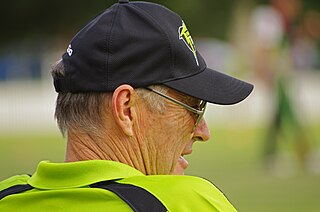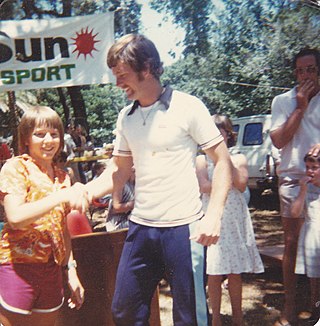Trevor Martin Chappell is a former Australian cricketer, a member of the South Australian Chappell family which excelled at cricket. He played 3 tests and 20 One Day Internationals for Australia. He won the Sheffield Shield with New South Wales twice, and scored a century for Australia against India in the 1983 World Cup. His career was overshadowed, however, by an incident in 1981 in which he bowled an underarm delivery to New Zealand cricketer Brian McKechnie to prevent the batsman from hitting a six.
Graham Neil Yallop is a former Australian international cricketer. Yallop played Test and One Day International cricket for the Australia national cricket team between 1976 and 1984, captaining the side briefly during the World Series Cricket era in the late 1970s. A technically correct left-handed batsman, Yallop played domestically for Victoria, invariably batting near the top of the order and led Victoria to two Sheffield Shield titles. He was the first player to wear a full helmet in a Test match.
Raymond James Bright is a former Australian Test and One Day International cricketer from Victoria. He was a left arm spin bowler and right handed lower order batsman who captained Victoria for a number of seasons. He was also an Australian vice-captain.

John Dyson is a former international cricketer (batsman) who is now a cricket coach, most recently in charge of the West Indies.
Timothy Joseph Zoehrer is a former Australian cricket player. He played as a wicket-keeper and is of Austrian descent.
Wayne Bentley Phillips is a former Australian cricketer who played in 27 Test matches and 48 One Day Internationals (ODIs) between 1982 and 1986 as a batsman and wicket-keeper. He played for South Australia between 1978 and 1991.
Rodney Malcolm Hogg is an Australian former cricketer. He was a fast bowler. Hogg played in 38 Test matches and 71 One Day Internationals between 1978 and 1985. In Tests he took 123 wickets at an average of 28.47. He is best remembered for taking 41 wickets in his first six tests during the 1978–79 Ashes.
Richard Bede McCosker is a former Australian cricketer. He was a part of the Australian squad which finished as runners-up at the 1975 Cricket World Cup.

Stephen John Rixon is an Australian cricket coach and former international cricketer. He played in 13 Test matches and six One Day Internationals between 1977 and 1985. He has coached the New Zealand cricket team, New South Wales cricket team, Surrey County Cricket Club, Hyderabad Heroes and the Chennai Super Kings of the Indian Cricket League and was the fielding coach of the Australian national cricket team, Pakistan national cricket team and Sri Lanka national cricket team.
Steven Barry Smith is a former Australian and New South Wales cricketer. He played in three Test matches and 28 One Day Internationals between 1983 and 1985, taking part in tours of Sri Lanka, the West Indies, and India.
Geoffrey Dymock is an Australian former international cricketer. He played in 21 Test matches and 15 One Day Internationals between 1974 and 1980. On his debut, he took five wickets in the second innings against New Zealand in Adelaide in 1974. He was the third bowler to dismiss all eleven opposition players in a Test match, and remains one of only six bowlers to have achieved this.
Peter Raymond Sleep is a former Australian cricketer who played 14 Test matches for Australia between 1979 and 1990.
Gary John Gilmour was an Australian cricketer who played in 15 test matches and five One Day Internationals (ODIs) between 1973 and 1977. He was a part of the Australian squad which finished as runners-up at the 1975 Cricket World Cup.
Alan George Hurst is a former Australian cricketer who played in twelve Test matches and eight One Day Internationals between 1975 and 1979. He was a part of the Australian squad which finished as runners-up at the 1975 Cricket World Cup.
Robert Byers Kerr is an Australian former cricketer who played in two Test matches and four One Day Internationals in 1985. He represented Queensland in four Sheffield Shield finals.
Glenn Samuel Trimble is a former cricketer who represented Australia and Queensland. A batsman who preferred to play straight, and a part-time medium pace bowler, Trimble was a regular member of the Queensland side in the mid-1980s, and won an Esso Scholarship in 1986, playing with the Essex County Cricket Club Second XI in England.
Kenneth Hervey MacLeay is a former English-born Australian cricketer.
Wayne Maxwell Clark is a former Australian cricketer who played in 10 Test matches and two One Day Internationals between 1977 and 1979.
Kevin John Wright is an Australian former Test cricketer.
The Australian cricket team toured India in the 1986–87 season to play a three-match Test series and a five-match one day international series against India.

